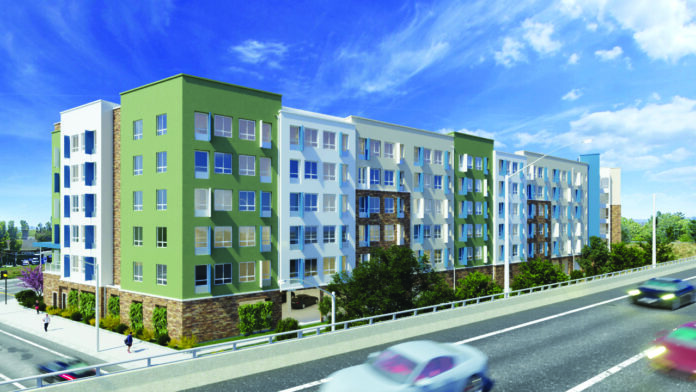P4, an off-the-shelf system for opening a new modular factory, draws lessons from one of the leading automated housing operations.
- The P4 Housing Collective’s system includes all elements a manufacturer will need to set up a new housing factory.
- The founders believe that the system will make it possible for more companies to move in this direction.
- Although the founders are focused on affordable housing, the system can be used to construct a factory for any type of product, from homes to apartments to hotels.
Could automated, factory-based, modular construction be the solution to fill the need for affordable housing? That’s what the P4 Housing Collective, based in Boise, Idaho, is betting on. They have created an off-the-shelf manufacturing system that they say they can use to help companies set up new, automated manufacturing plants, even if they have no past manufacturing experience.
The collective is a partnership between four companies: Waypaver International (facility design and automation), Prefab Logic (digital technology), Modular Maven (human resources consulting and office design) and Effektive House (an architectural plan service).
Together, these companies offer what they’ve named “System P4,” in partnership with KUKA, an automation and robotics company based in Germany. System P4 provides a predesigned manufacturing facility, with the goal of empowering companies to start factories for home construction.

Sharing Knowledge
The collective’s members have many years’ combined experience in the industry, and they say they want to make it easier for newcomers to enter the field by doing the groundwork for them. “It’s about sharing knowledge and helping new companies avoid the same mistakes that others have made,” said Rick Murdock, co-founder of Waypaver International.
Murdock brings a lot of expertise to this new endeavor. He is also co-founder of Autovol in Nampa, Idaho, which owns and operates the highest volume automated modular factory in the Western US. System P4 seems to have drawn a lot of lessons from Autovol’s experience setting up and running an automated housing plant.
Most of the buildings Autovol constructs are multifamily structures with four or five stories. They are a good fit for apartments in high-density cities or for workforce housing in smaller communities. However system P4 isn’t limited to apartments: it can also be used to set up plants for the manufacture of mass subdivisions of rental housing, or for chains of hotels.
The Model
Murdock’s business partner at Autovol and Waypaver is Curtis Fletcher. (The pair also co-counded Prefab Logic.) Fletcher says that Autovol’s modular units are constructed with finished interiors that include bathtubs, sinks, cabinets and plumbing. The drywall is finished offsite.
“Offsite, the building is already plumbed,” he explains. “Workers [at the jobsite] just make the connections from building to building and from unit to unit.”
The electrical wiring is also mostly done at the factory. “Everything’s tested, all the lights work, fans work, ranges work. Once the builders get set, that crew will come into the building and hook up their connections,” adds Murdock.
The units are wrapped with a vapor barrier and waterproofing material that protects them during transportation. The on-site contractor takes it from there, finishes off the exterior and adds any façade they want to add. On-site workers also add exterior finishes such as stucco or brick, and install roofs.
The Autovol co-founders cited many advantages of factory automation. “There’s lots of labor benefits,” Murdock says. “The construction work is done by robots [in the factory], so there’s not a lot of heavy lifting. The labor pool is wiring those units, plumbing those units, and installing cabinetry and other finishes.” He estimates that the automation piece accounts for about 45% of the work.

Modular Savings
Statistics from Autovol and P4 claim that factory production can cut construction time in half. The dollar cost savings will vary by where the building is located. In the San Francisco Bay Area, a company could shave $90 to $120 per sq. ft. of the final build price. In other, less expensive cities, there might be a $40 per sq. ft. savings. And in areas that already have a low cost of construction, saving time might be the key benefit rather than lowering cost.
Construction materials are less likely to be lost or stolen if most of the work is done in a factory, Murdock says. The manufacturing plant is a controlled environment that is easier to manage than an outdoor construction site. At the manufacturing plant, supervision and quality assurance can be more consistent.
Collective members believe that this approach can help address the global need for affordable housing, especially multifamily apartment buildings.
“We’ve been doing traditional construction for hundreds of years. We love it and it is always going to be necessary [to some extent]. However it’s also the only industry in our country that’s gone backwards in productivity and produces less every year,” Murdock says. “Manufacturing gives you an opportunity to increase your volume, build more, in most cases for less, and in half the time.”
To support this statement, Murdock mentions the 2020 McKinsey & Company report The Next Normal in Construction. This report says the construction industry has been slow to adopt digital tools and to modernize. “In the past couple of decades, it also has been plagued by dismal performance,” says Murdoch. It is the largest industry in the world economy.

“We’re not promoting getting rid of traditional construction,” Murdock adds. “We’ll always need that. We’re promoting the two industries tying themselves together to complete more projects and supply more affordable housing for the masses.”
During a phone interview, Murdock said that P4 is currently working with a handful of companies on new factories, though he declined to name them or to say how many.
Kat Friedrich writes about energy, engineering, physics and technology. She is a graduate of the University of Wisconsin-Madison College of Engineering and is the editor in chief of Solar Today. Photos courtesy Autovol.

















